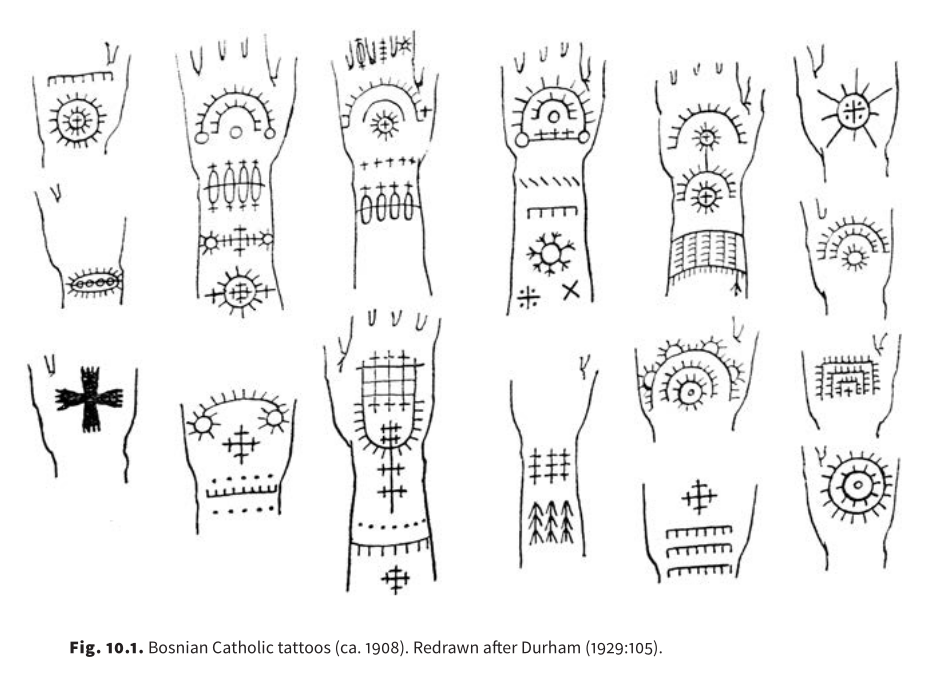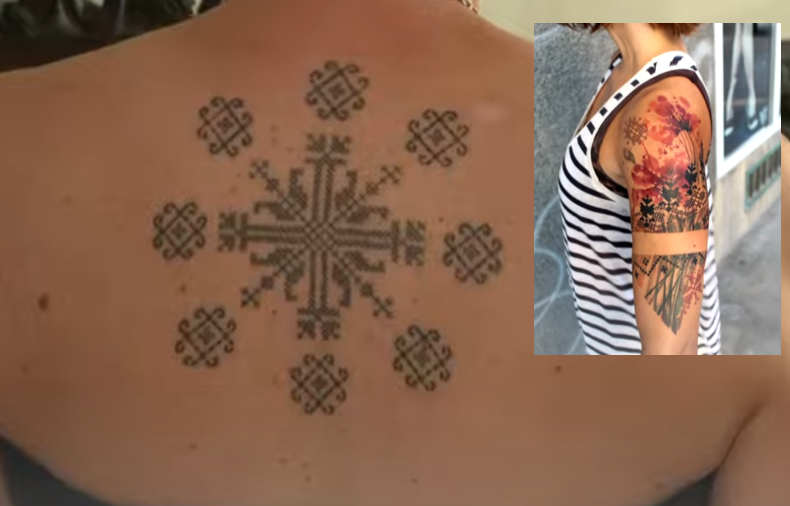Ancient Slavic and European tattoos
Tattooing in Europe is ancient. The famous mummy Ötzi, who lived in Europe around 3370-3310 BCE, had tattoos.
Tattoo traditions in the Balkans
In the book Ancient Ink: The Archaeology of Tattooing, Lars Krutak offers a chapter on historical tattoo practices in the Balkans (specifically Bosnia and Herzegovina and Croatia).
The following illustration, from that book chapter, shows some historical Bosnian tattoos.

I find this chapter deeply fascinating for a few reasons:
- The tattoos tend to have Catholic meaning. However, the tradition of these tattoos and even many of these specific symbols actually seems to pre-date Catholicism on the region (its origin having been placed somewhere in the ballpark of 300 BCE). If I understand correctly, it seems that the tradition was later assigned new meanings in terms of the Catholic religion. (This isn’t unusual - it has been demonstrated elsewhere that particular tattoo designs have fluid meanings, which can change even through the course of a single person’s life.)
- Like tattoo traditions from elsewhere in the world, this tradition seems to have been especially associated with women.
- The communist government and society frowned upon these tattoos as primitive. The book chapter reports the story of a woman, who had cross tattoos on her hands and chest, facing the risk of losing her job.
- This tradition is now seeing a revival. One tattoo artist quoted in the book chapter attributes this to globalisation and cultural homogenisation around the world, which are causing people to look to the past to find unique facets of their identity.
(Update 2025-06-02: I just encountered this very cool Wikipedia article that also describes traditional tattooing in Albania.)
Who are the Slavic people?
Before coming to Australia, my mother’s side of my family lived in Slovakia. My grandfather on my mother’s side was a Catholic mathematician who also had trouble with the communist government of Czechoslovakia, and this tense relationship with the communists was part of why the family moved to Australia. You can see why that story about Balkan tattoo traditions resonates with me!
According to Wikipedia, Slavs are divided into three groups:
- West Slavs (including Slovaks and Czechs) - my mother’s family
- South Slavs (including Bosniaks and Croats) - the people to whom the above Bosnian and Croat traditions belong
- East Slavs (including Russians and Ukrainians)
Tattoo traditions in the West Slavs
I’m very curious to know whether there is a similar tradition of tattooing in the West Slavs, such as the Slovaks and Czechs to which my mother’s family belongs.
Some useful pieces of evidence:
- The Venus of Predmost is a piece of engraved mammoth ivory, found in the 1890s near Přerov in today’s Czechia and dating to ~26,000-20,000 BCE. The ivory is engraved with a female body composed of gemoetric designs. It has been suggested that the geometric designs could depict tattoos or scarification, though the designs could also depict body hair, clothing, body paint, or stretchmarks (Renaut 2017).
- There have been tattooed mummies, dating from the fifth through third centuries BCE (roughly the same time as the Bosnian tattoo tradition I mentioned above), in the Altai Mountains. This mountain range is in central Russia. There is also clear evidence of tattooing by the Sarmatians and Scythians, nomadic peoples who inhabited the Pontic-Caspain Steppe (Yablonsky 2018). This is still a bit to the east of Slovakia itself, but it’s very close by, and there was lots of cultural interchange over the centuries. There might also be selection bias here—in this part of the world, the further east you go, the more likely bodies are to be preserved in the soil.
- Oetterman (2000) writes, in a book chapter about tattooed entertainers in America and Germany: “A surprising number of tattooed men on the German scene were Czechs, whose main trade was to perform as fakirs, fire-eaters or acrobats. Among them were Roustan, Ramses and Don Manuelo, ‘the best and truly most artistically tattooed of men, resplendent in many colours-such beauty, artistry and grace’.”
- Likhoded writes, in a piece of popular writing (not scholarly): “It is known that the warriors of the forefather of the royal family Rurik wore a falcon on their shoulder, made in the form of a trident. This sign testified that the youth became a warrior. Today, such a tattoo is popular in Ukraine, and the falcontrident is used in national symbolism. People who performed ritual pagan rites covered their bodies with certain colors and tattoos. Their colors signified their belonging and closeness to higher powers. And if ordinary mortals applied temporary drawings to themselves during rites, then the guardians of the faith made them lifelong. It is difficult to say what kind of tattoo existed in the first Slavic tribes. It can be assumed that these were simple drawings in the form of diamonds, crosses and other primitive symbols. Over time, the drawings became more complex, and the area of the body covered by the tattoo increased.”
- This excellent thesis by Barbora Truksová gives some history of tattoos in Europe, but reports that “we have no documents about the earliest development of tattoos in the Czech Republic”. In the 19th and 20th centuries, opera singer Ema Destinnová received a tattoo of a snake on her leg, and Archduke Franz Ferdinand (while not Czech himself) received in Tokyo a tattoo of a dragon on his shoulder! There are a few publications on tattoos in the early 20th century, especially among soldiers, criminals, performers, and so on.
So, it seems to me that there probably were tattoos happening in some form throughout Slovak and Czech history—after all, we have very clear evidence of tattoo traditions just to the south and just to the east of Slovakia/Czechia. We know that there was lots of movement (including nomads) and cultural exchange in this part of the world for thousands of years (hence the very close cultural and linguistic ties that persist to this day), and we know that the east is where human bodies are more likely to be preserved. In fact, it has been suggested that the Bosnian tradition was closely related to traditions from elsewhere in the Balkans and the Near East and that these traditions spread north and west via cultural exchange across Europe, perhaps reaching people in Germany (like the mummy Ötzi) and the British Isles during the Neolithic period (i.e. by around ~2,000 BCE) (Renaut 2017). If this is correct, then this would be a collection of related traditions happening across Europe and parts of Asia over the past few thousand years.
To me, these various pieces of evidence suggest that tattooing was happening in Slovakia/Czechia over the past couple of thousand years. But if this hypothesis is correct, Slovak/Czech traditions do not appear to have been studied in the same way as the Bosnian and Croat tattoo tradition or the archaeological discoveries in Russia. I think this is a real shame and a loss to Slovak and Czech heritage.
I’m not the only one interested in Slovak and Czech history and tattoos. This Reddit thread shows that at least one other person is interested in West Slavic tattoo history but can’t find any information!
Also, the Slovak tattoo artist Andrea “Adra” Kopecká uses designs inspired by traditional Slovak embroidery (Youtube). Kopecká’s designs are astonishingly beautiful and intricate. Here are two that I picked at random from that Youtube video:
